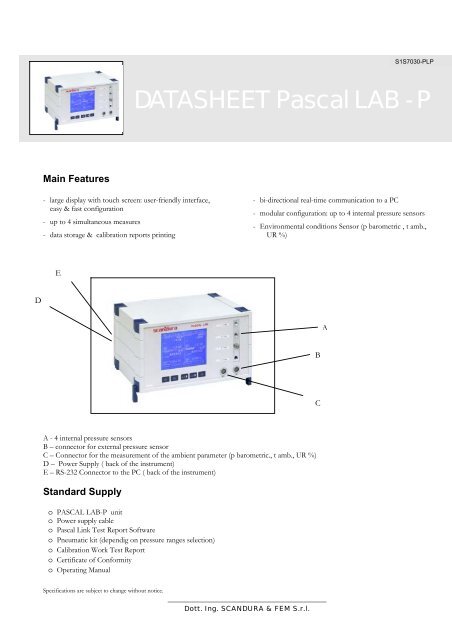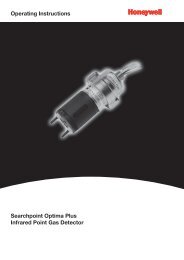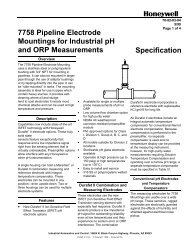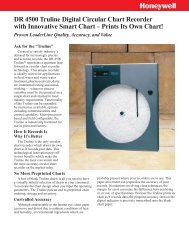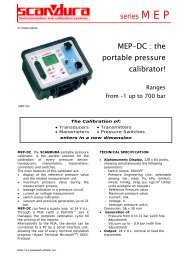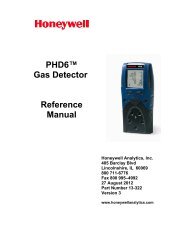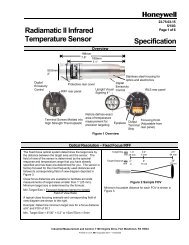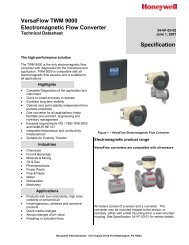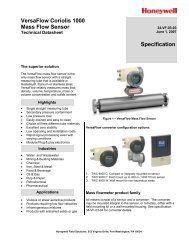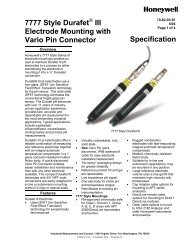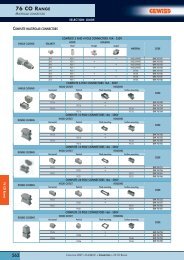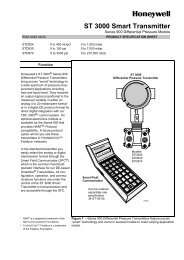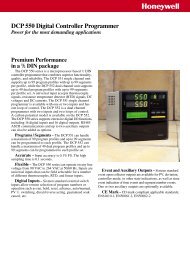DATASHEET Pascal LAB - P - Merkantile
DATASHEET Pascal LAB - P - Merkantile
DATASHEET Pascal LAB - P - Merkantile
Create successful ePaper yourself
Turn your PDF publications into a flip-book with our unique Google optimized e-Paper software.
S1S7030-PLP<br />
<strong>DATASHEET</strong> <strong>Pascal</strong> <strong>LAB</strong> - P<br />
Main Features<br />
- large display with touch screen: user-friendly interface,<br />
easy & fast configuration<br />
- up to 4 simultaneous measures<br />
- data storage & calibration reports printing<br />
- bi-directional real-time communication to a PC<br />
- modular configuration: up to 4 internal pressure sensors<br />
- Environmental conditions Sensor (p barometric , t amb.,<br />
UR %)<br />
E<br />
D<br />
A<br />
B<br />
C<br />
A - 4 internal pressure sensors<br />
B – connector for external pressure sensor<br />
C – Connector for the measurement of the ambient parameter (p barometric., t amb., UR %)<br />
D – Power Supply ( back of the instrument)<br />
E – RS-232 Connector to the PC ( back of the instrument)<br />
Standard Supply<br />
o PASCAL <strong>LAB</strong>-P unit<br />
o Power supply cable<br />
o <strong>Pascal</strong> Link Test Report Software<br />
o Pneumatic kit (dependig on pressure ranges selection)<br />
o Calibration Work Test Report<br />
o Certificate of Conformity<br />
o Operating Manual<br />
Specifications are subject to change without notice.<br />
______________________________________<br />
Dott. Ing. SCANDURA & FEM S.r.l.
Accessories on request<br />
<strong>Pascal</strong> Link - Test Report Software<br />
o<br />
o<br />
o<br />
o<br />
Environmental parameters sensor<br />
Calibration Certificate ( Italian SIT)<br />
Pneumatic pressure kit ( code depending on pressure range)<br />
Handheld Hydraulic Pressure Generator, model:<br />
GHM: range 0 ÷ 300 bar<br />
GHM-H: range 0 ÷ 400 bar<br />
GHH: range: 0 ÷ 700 bar<br />
Fluid: hydraulic oil<br />
It is the most user friendly program on the market. It<br />
has an immediate impact on the calibration operations<br />
allowing configuration, in A4 format, of the calibration<br />
reports and/or certificates according to users<br />
standards.<br />
Automatic calibration and set-up data transfer (over RS<br />
232 serial interface) makes <strong>Pascal</strong> Link the safer<br />
software system to support any calibration procedure<br />
according to ISO 9000 standards.<br />
Operating platform: MS-Windows '98 or higher<br />
General specifications<br />
Power Supply:<br />
Display:<br />
Keyboard:<br />
Communication Ports:<br />
Dimensions:<br />
Weight:<br />
In: 100÷240 V ac 50÷60 Hz<br />
320 x 240 Dots<br />
Dot size:0,34 x 0,34 mm<br />
(0,013 x 0,013 in)<br />
Eff. Area: 122 x 92 mm<br />
(4,6 x 3,6 in)<br />
Backlight: LED<br />
Touch-screen + 5 keys<br />
RS-232 connector<br />
External Pressure module<br />
Environmental sensor connector<br />
approx. 170Hx260Wx300L<br />
approx. 3.5 Kg<br />
Operating temperature: -10 ÷ 50 °C (14 ÷ 122 °F)<br />
Operating Humidity: 10 % ÷ 90 % not cond.<br />
Storage Temperature: -30 ÷ 80 °C<br />
(-22 ÷ 176 °F)<br />
Storage Humidity: 0 % ÷ 90 % not cond.<br />
Standards: CEI EN 61326-1 (1998)<br />
EN 55011(1999)<br />
EN 6100-4-2 (1995)<br />
EN 6100-4-3 (1996)<br />
EN 6100-4-4 (1995)<br />
Order code<br />
PASCAL <strong>LAB</strong> -xx -x<br />
Pressure<br />
One internal range<br />
Two internal ranges<br />
Three internal ranges<br />
Four internal ranges<br />
P1<br />
P2<br />
P3<br />
P4<br />
OPTION<br />
Environmental parameters sensors ( P abs -T-RH ) A<br />
Notes:<br />
─ Code P251H can be combined with P1 and P2 only<br />
Specifications are subject to change without notice.<br />
______________________________________<br />
Dott. Ing. SCANDURA & FEM S.r.l.
Pressure module<br />
Internal transducers<br />
Type Range Accuracy<br />
(% fs)<br />
Uncertainty<br />
(% fs)<br />
Typical<br />
Resolution<br />
Gauge<br />
701G 0 ÷ 7 bar 0,015 0,025 0,1 mbar 1,2,3<br />
212G 0 ÷ 21 bar 0,015 0,025 0,1 mbar 1,2,3<br />
060G -60÷ 60 mbar 0,08 0,1 0,01 mbar 1,2,3<br />
500G -500 ÷ 500 mbar 0,015 0,025 0,01 mbar 1,2,3<br />
151G -900 ÷ 1500 mbar 0,015 0,025 0,01 mbar 1,2,3<br />
Absolute<br />
151A 0 ÷ 1500 mbar abs. 0,015 0,025 0,01 mbar 1,2,3<br />
251A 0 ÷ 2500 mbar abs. 0,015 0,025 0,01 mbar 1,2,3<br />
501A 0 ÷ 5 bar abs. 0,015 0,025 0,1 mbar 1,2,3<br />
701A 0 ÷ 7 bar abs. 0,015 0,025 0,1 mbar 1,2,3<br />
212A 0 ÷ 21 bar abs. 0,015 0,025 0,1 mbar 1,2,3<br />
1 One year specifications<br />
2 Temperature effect: 0,002 % rdg/|t – t c | for t : 0 °C ≤ t ≤ 18 °C and 28 °C ≤ t ≤ 50 °C and t c = 20 °C<br />
3 pneumatic connection: depend on the <strong>Pascal</strong> <strong>LAB</strong> model<br />
External transducers<br />
Type Range Accuracy<br />
(% fs)<br />
Uncertainty<br />
(% fs)<br />
Typical<br />
Resolution<br />
Gauge<br />
PSP-1/1.5 -900 ÷ 1500 mbar 0,015 0,025 0,01 mbar 1,2,3<br />
PSP-1/8 -1 ÷ 7 bar 0,015 0,025 0,1 mbar 1,2,3<br />
PSP-1/22 -1 ÷ 21 bar 0,015 0,025 0,1 mbar 1,2,3<br />
PSP-1/50 0 ÷ 50 bar 0,015 0,025 1 mbar 1,2,3<br />
PSP-1/100 0 ÷ 100 bar 0,015 0,025 1 mbar 1,2,3<br />
PSP-1/200 0 ÷ 200 bar 0,07 0,09 10 mbar 1,2,3<br />
PSP-1/400 0 ÷ 400 bar 0,07 0,09 100 mbar 1,2,3<br />
PSP-1/700 0 ÷ 700 bar 0,07 0,09 100 mbar 1,2,3<br />
Absolute<br />
PSP-1/1.5A 0 ÷ 1500 mbar Abs. 0,015 0,025 0,01 mbar 1,2,3<br />
PSP-1/2.5A 0 ÷ 2500 mbar Abs. 0,015 0,025 0,01 mbar 1,2,3<br />
PSP-1/81A 0 ÷ 80 bar abs 0,015 0,025 1 mbar 1,2,3<br />
1 One year specifications<br />
2 Temperature effect: 0,002 % rdg/|t – t c | for t : 0 °C ≤ t ≤ 18 °C and 28 °C ≤ t ≤ 50 °C and t c = 20 °C<br />
3 pneumatic connection: depend on the <strong>Pascal</strong> <strong>LAB</strong> model<br />
Note<br />
Note<br />
Other pressure ranges and high accuracy (0,01 % fs) sensors available on request<br />
Environmental parameters module<br />
Parameter Range Accuracy Uncertainty Max<br />
Resolution<br />
Temperature (-10 ÷ 50) °C 1,5 °C 1,8 °C 0,1 °C<br />
Barometric Pressure (650 ÷ 1150) mbar 4 % fs 5 % fs 1 mbar<br />
Relative Humidity 10 % ÷ 90 % 4 % 5 % 1 %<br />
Note<br />
Specifications are subject to change without notice.<br />
______________________________________<br />
Dott. Ing. SCANDURA & FEM S.r.l.
How to compare specifications<br />
Accuracy or Uncertainty<br />
Usually the SCANDURA declarations concerning the metrological aspects involve the uncertainty approach.<br />
Since some ambits seem to prefer a declaration that involves the word “Accuracy” instead of the “Uncertainty”, we have<br />
decided to report this value into our specifications also, giving to the customer the possibility to understand the difference.<br />
Actually, in a different way from what it happens for the “Uncertainty”, that it is well defined, the “Accuracy” it is not: in<br />
details, referring to the international rules, the term “ accuracy” is just a qualitative term ( e.g. you can say that a measurement is<br />
“accurate” or “not accurate”) instead the “Uncertainty” is a quantitative term. Accordingly when a “plus or minus” figure is<br />
quoted, it should be only an “Uncertainty”, not an “Accuracy”: in spite of this fact, many technical datasheets report the term<br />
“Accuracy” followed by a number. In general it’s possible to read that the “Accuracy” includes: non-linearity, hysteresis and<br />
non-repeatability. so, under the name “Accuracy”, we have reported the contribution of these components to the Total<br />
Extended Uncertainty. In the same way, under the name “Uncertainty” the Total Extended Uncertainty has been reported: this<br />
value includes all the components of the Uncertainty and has been given with a confidence level of around 95 %. Only to give<br />
an idea on how these values have been carried out we report here below the components of the “Accuracy” and those of the<br />
“Uncertainty” taken into consideration.<br />
Accuracy:<br />
- hysteresis<br />
- non-repeatability<br />
- non-linearity<br />
Uncertainty:<br />
- hysteresis<br />
- non-repeatability<br />
- non-linearity<br />
- instrument resolution<br />
- indication error<br />
- uncertainty of the reference<br />
instrument used to measure the<br />
components above-mentioned<br />
The methods to calculate the contribution of these components are in accordance to the international rules: ISO GUM “Guide<br />
to Expression of Uncertainty in Measurement”, ISO ENV 13005.<br />
For the declaration of the “Accuracy” see: ISA 51.1<br />
Temperature compensation<br />
As the instrument can be used in different environmental conditions, the correction of the indication error due to the<br />
temperature effect has be done separately.<br />
For the pressure parameters:<br />
temperature effect: 0,002 % rdg/|t – t c | from 0 °C to 50 °C<br />
where:<br />
- t c is the calibration temperature equal 20 °C;<br />
- t is the ambient temperature;<br />
- % rdg means that the value is reported in percent of the measuring point reading (eg.: 10 bar).<br />
E.g.: if the instrument will be used at a temperature t equal to 20 °C this temperature error contribution will be equal zero.<br />
Percent of reading or full scale<br />
The “Accuracy” such as the “Uncertainty” can be declared in percentage of the reading (% rdg) or in percentage of the full<br />
scale (% fs).<br />
For the pressure parameters (e.g.: for strain gauge pressure sensors) we declare in percent of the full scale. Why? In this case, in<br />
fact, the hysteresis contribution, that is an important value in the calculation process, strictly depends on the maximum pressure<br />
point and, to be conservative, we assume for this value the full scale.<br />
Specifications are subject to change without notice.<br />
______________________________________<br />
Dott. Ing. SCANDURA & FEM S.r.l.


